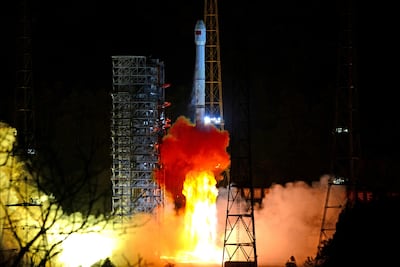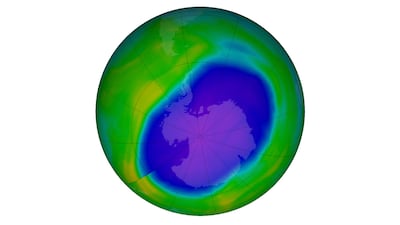A growing global desire to venture into deep space could pose a new threat to life back on Earth – 40 years after the alarm was raised over damage to the ozone layer and its stark consequences for humankind.
It was 40 years ago this month that a team of scientists from the British Antarctic Survey published a study that sent shock waves through not just the scientific community, but the world as a whole.
They revealed that, from the late 1970s onwards, a hole had been forming each southern hemisphere spring in the ozone layer above the Antarctic.
It was a human-made crisis, because the thinning had been caused by the release into the atmosphere of chlorofluorocarbons (CFCs) and related substances used as refrigerants and aerosol propellants.
Left unchecked, this destruction could have had increasingly serious consequences, because ozone – a gas whose molecules are made up of three oxygen atoms – filters out the most harmful solar radiation and allows life as we know it to exist.
Slowly, the Antarctic hole is healing, thanks largely to the groundbreaking Montreal Protocol, an agreement that came into force in 1989 to restrict the use of CFCs and related gases containing chlorine and bromine.
New challenges take flight
But even as the crucial healing process continues, the international community is being urged to remain vigilant.
In particular, researchers are concerned that rockets that take off for space exploration and to launch satellites are causing damage because the exhausts of these craft release soot directly into the stratosphere.
The National Oceanic and Atmospheric Administration (NOAA), a US government agency, released a study in 2022 suggesting that “a significant boost in space flight activity may damage the protective ozone layer”.
Also, when satellites reach the end of their life, return to the Earth’s atmosphere and burn up, they release nitrogen oxide, chlorine, aluminium and lithium, which can destroy ozone.

The UK’s University of Southampton said last year that up to 50,000 satellites could be launched into orbit by 2030, while each day over the coming decade dozens will re-enter the Earth’s atmosphere and burn up.
Rasmus Flytkjaer, head of space at the consultancy London Economics, says that it is unclear if concerns about the environmental impacts of launches and re-entries are having “an observable impact” on the industry.
The problem of space debris continues to grow, which may indicate that environmental impacts from the industry are tackled only when appropriate regulations are in place.
Yet Mr Flytkjaer says that standardised global regulations have yet to be put in place, and the sector is “looking to the UN to become that organisation” that brings them in.
“As the countries haven’t agreed, the UN have to tackle this,” he says. “There are differences between jurisdictions, meaning that satellites not approved in one jurisdiction may be approved in another.”
If suitable regulations are in place, the impacts could be much reduced: Mr Flytkjaer said that a wooden satellite, LignoSat, launched last year, was used to demonstrate that satellites did not have to be made from metals that harmed the ozone layer.
Another concern is the possibility of hypersonic air travel, which would involve aircraft flying at five times the speed of sound or more. Several companies are developing this technology.
“They will be flying high up, maybe at 30km altitude,” says Prof Guy Brasseur, of the Max Planck Institute for Meteorology in Germany and the National Centre for Atmospheric Research in the US.
“I don’t know how much the engines will emit because nobody knows what kinds of engine will be used, but there’s the potential for emissions of large amounts of water vapour and nitrogen oxide depending on the technology used.”
Further threats include climate change, which with its complex effects on the atmosphere, could cause damage in more than one way.
“Climate change with change the circulation of the stratosphere. It’s predicted to make the ozone column in the tropics thinner. The tropics is a region that’s not really had depletion in the past, but it’s where lots of people live,” Prof Brasseur says.
Also, Prof Brasseur says that even as the troposphere warms, global warming will lead to a cooling of the stratosphere, which is likely to result in clouds forming in the stratosphere above the poles more frequently.
The interaction of clouds, CFCs and ozone could result in more ozone being destroyed and a thinning of the protective layer above the Antarctic.
So, while the world can celebrate the progress made so far in helping to heal the hole in the ozone layer, the future of his critical protective chief remains uncertain.
How ozone hole led to global concern
“I guess it was the first strong indication of humans on the planet Earth could have a global impact on the environment, in a supposedly pristine, remote region,” said Prof Martyn Chipperfield, who researches the ozone layer at the University of Leeds in the UK.
“The ozone layer is essential for life on Earth. Life would not have evolved without the ozone layer forming … because it filters out short-wavelength harmful ultraviolet radiation. There’s strong, justified concern about us damaging the ozone layer.”
The protective ozone layer lies in the stratosphere, which sits between about 11 and 50km above the Earth’s surface, directly on top of the troposphere, which stretches up from ground level.
The coldness of the stratosphere above the Antarctic accelerates the depletion of ozone by CFCs, and the Arctic too has experienced thinning, but less because temperatures inside the stratosphere there are not as low.
Life-saving progress
A 2020 report from the US Environmental Protection Agency said that, when considering people born in the US up to the year 2100, the protocol is expected to prevent about 63 million cataract cases, 443 million skin cancer cases and 2.3 million skin cancer deaths.
Prof Chipperfield describes the protocol as having been “a big success”, but he cautions that the atmospheric abundance of ozone-depleting gases “will only gradually decay” because CFCs and similar compounds are stable and remain in the atmosphere for many decades.
“The hole still appears very strongly most years, but the rate at which it grows in September is slowing down. So we do think the Antarctic ozone hole is responding to the decreases in chlorine and bromine,” he says.
Prof Chipperfield – who completed his PhD under the supervision of the late Joe Farman, one of three authors of the original report about the ozone hole – said that it will not be until around 2070 that the ozone layer over the Antarctic returns to its 1980 state, which is typically used as the baseline for comparisons.



